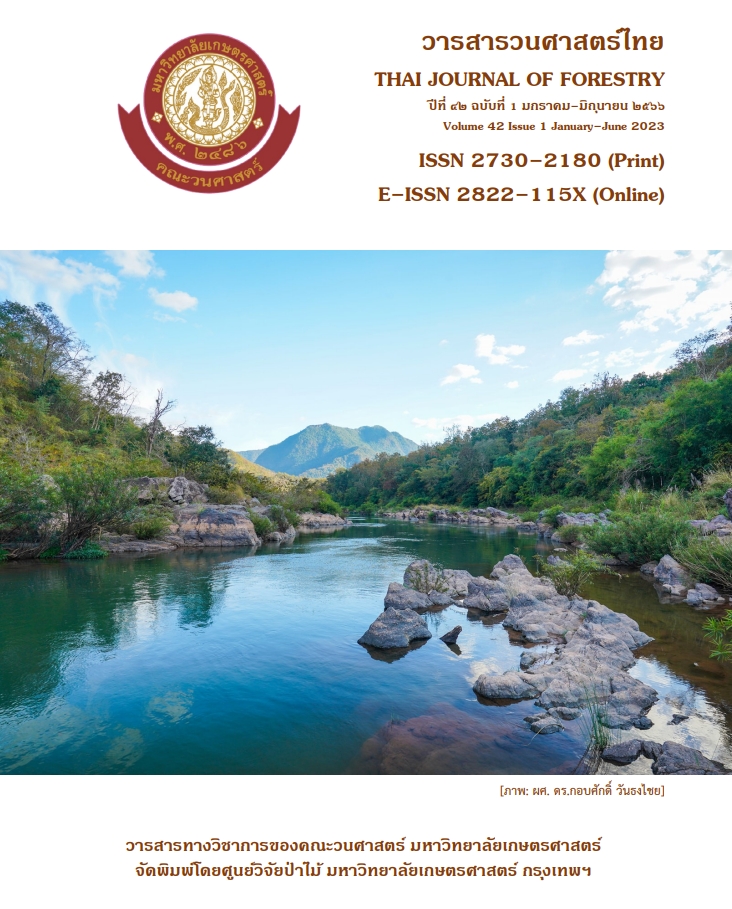โครงสร้างทางสังคมของมดที่อาศัยอยู่ตามพื้นดินในพื้นที่การใช้ประโยชน์แตกต่างกัน บริเวณเขตห้ามล่าสัตว์ป่าอ่างเก็บน้ำบางพระ จังหวัดชลบุรี
Main Article Content
บทคัดย่อ
การศึกษาโครงสร้างทางสังคมของมดที่อาศัยอยู่ตามพื้นดินในพื้นที่การใช้ประโยชน์แตกต่างกัน บริเวณเขตห้ามล่าสัตว์ป่าอ่างเก็บน้ำบางพระ จังหวัดชลบุรี มีวัตถุประสงค์เพื่อ 1) ศึกษาโครงสร้างทางสังคมของมด 2) ทราบชนิดมดอันตรายและมดต่างถิ่น ที่อาศัยอยู่ตามพื้นดิน 3) มีฐานข้อมูลของมดที่อาศัยอยู่ตามพื้นดินที่พบในพื้นที่ศึกษา ซึ่งข้อมูลการศึกษาในครั้งนี้จะนำไปสู่การแก้ปัญหากรณีมดที่มีผลต่อสุขภาพ หรือมดอันตรายในพื้นที่ได้ เพื่อลดผลกระทบระหว่างมนุษย์กับมด โดยวางกับดักมดเป็นแนวยาวใน 5 พื้นที่ที่ต่างกันได้แก่ บริเวณลานกางเต็นท์ บริเวณบ้านพักเจ้าหน้าที่ ป่าปลูกแบบผสม ป่าจามจุรี และบริเวณเส้นทางศึกษาธรรมชาติ ซึ่งใช้เหยื่อสองชนิด ได้แก่ เหยื่อทูน่า และเหยื่อน้ำหวาน จำนวนเหยื่อละ 20 จุด จับเวลา 30 นาที แล้วทำการเก็บข้อมูลมด บันทึกชนิด และจำนวนตัว ทั้ง 5 พื้นที่ โดยทำการเก็บข้อมูลทุกๆ สองเดือน เป็นระยะเวลา 10 เดือน ระหว่างเดือนพฤศจิกายน 2564 ถึง เดือนสิงหาคม 2565 รวมเก็บข้อมูลทั้งหมดจำนวน 5 ครั้ง
ผลการศึกษาพบมดทั้งหมด 45 ชนิด 32 สกุล 7 วงศ์ย่อย โดยพบมดในวงย่อย MYRMICINAE มากที่สุด คิดเป็นร้อยละ 44.44 โดยบริเวณป่าปลูกแบบผสม มีค่าดัชนีความหลากหลายทางชนิด และดัชนีความสม่ำเสมอสูงที่สุด เท่ากับ 2.56 และ 0.78 ตามลำดับ บริเวณบ้านพักเจ้าหน้าที่และลานกางเต็นท์มีค่าดัชนีความคล้ายคลึงมากที่สุดคิดเป็นร้อยละ 77.55 มีค่าความมากมายของประชากรมดในพื้นที่ใช้ประโยชน์ 5 พื้นที่ เฉลี่ย 12.42 ตัวต่อกับดักเหยื่อ ซึ่งชนิดมดที่มีการกระจายมากที่สุดคือมดไอ้ชื่นดำ (Odontoponera denticulata) มดที่มีค่าการปรากฏมากที่สุด คือมดแดง (Oecophylla smaragdina) โดยพบชนิดมดที่มีผลต่อสุขภาพที่สำคัญ ได้แก่ มดคันไฟ (Solenopsis geminata) มดหนามคู่สีเทา (Diacamma orbiculatum) มดไอ้ชื่นดำ (Odontoponera denticulata) มดเล็บหวีอกคอด (Leptogenys kitteli) และมดตะนอยอกแดง (Tetraponera rufonigra) และพบมดต่างถิ่น 6 ชนิด ได้แก่ มดดำทุ่ง (Iridomyrmex anceps) มดเหม็น (Tapinoma. melanocephalum) มดน้ำผึ้ง (Anoplolepis gracilipes) มดดำขายาว (Paratrechina longicornis) มดละเอียดบ้าน (Monomorium pharaonis) และมดคันไฟธรรมดา (S. geminata)
Downloads
Article Details

อนุญาตภายใต้เงื่อนไข Creative Commons Attribution-NonCommercial-NoDerivatives 4.0 International License.
ข้าพเจ้าและผู้เขียนร่วม (ถ้ามี) ขอรับรองว่า ต้นฉบับที่เสนอมานี้ยังไม่เคยได้รับการตีพิมพ์และไม่ได้อยู่ในระหว่างกระบวนการพิจารณาตีพิมพ์ลงในวารสารหรือสิ่งตีพิมพ์อื่นใด ข้าพเจ้าและผู้เขียนร่วม (ถ้ามี) ยอมรับหลักเกณฑ์และเงื่อนไขการพิจารณาต้นฉบับ ทั้งยินยอมให้กองบรรณาธิการมีสิทธิ์พิจารณาและตรวจแก้ต้นฉบับได้ตามที่เห็นสมควร พร้อมนี้ขอมอบลิขสิทธิ์ผลงานที่ได้รับการตีพิมพ์ให้แก่วารสารวนศาสตร์ คณะวนศาสตร์ มหาวิทยาลัยเกษตรศาสตร์ กรณีมีการฟ้องร้องเรื่องการละเมิดลิขสิทธิ์เกี่ยวกับภาพ กราฟ ข้อความส่วนใดส่วนหนึ่ง หรือ ข้อคิดเห็นที่ปรากฏในผลงาน ให้เป็นความรับผิดชอบของข้าพเจ้าและผู้เขียนร่วม (ถ้ามี) แต่เพียงฝ่ายเดียว และหากข้าพเจ้าและผู้เขียนร่วม (ถ้ามี) ประสงค์ถอนบทความในระหว่างกระบวนการพิจารณาของทางวารสาร ข้าพเจ้าและผู้เขียนร่วม (ถ้ามี) ยินดีรับผิดชอบค่าใช้จ่ายทั้งหมดที่เกิดขึ้นในกระบวนการพิจารณาบทความนั้น”
เอกสารอ้างอิง
Andersen, A.N. 2000. A global ecology of rainforest ants : Functional group in relation to environmental stress and disturbance.
In: Aonat Agosti, et al. (Eds.). Ants : Standard for Measuring and Monitoring Biodiversity. Smithsonian Institution press, United State of America, pp. 25-34.
Anonymous. 2019. Quickstats: Number of deaths from hornet, wasp, and bee stings, among males and females - national vital statistics system, united states,† 2000-2017. MMWR. Morbidity and mortality weekly report, 68: 649.
Bolton, B. 1994. Identification Guide to the Ant Genera of the World. Harvard University Press, United State of America.
Bourmas, C. 2005. Species Diversity of Ants at Huay Khayeng, Thong Pha Phum District, Khanchanaburi Province. M.S. Thesis, Kasetsart University. Bangkok, Thailand. (in Thai)
Forest and Plant Conservation Research Office. 2019. The Forest Area covers the Non-Hunting Area 2019. Department of National parks Wildlife and Plant Conservation, Bangkok. (in Thai)
Hasin, S. 2008. Diversity and Community Structure of Ants at Sakaerat Environmental Research Station, Nakhon Ratchasima Province M.S. Thesis, Kasetsart University. Bangkok, Thailand. (in Thai)
Hölldobler, B., Wilson, E.O. 1990. The Ants. Harvard University Press, United States of America.
Jaitrong, W., Suwannaphak, K., Samukkee, Y., Jeenthong, T. 2020. Ants of Thailand. National Science Museum Thailand, Bankok. (in Thai)
Krebs, C.J. 1972. Ecology : The Experimental Analysis of Distribution and Abundance. Harper and Row publisher, New York, USA.
Lach, L., Parr, C.L., Abbott, K.L. 2010. Ant Ecology. Oxford University Press, New York, USA.
Ludwig, J.A., Reynolds, J.F. 1988. Statistical Ecology. John Wiley & Sons, New York. Academy Press, Washington, D.C., USA.
Pannavalee, R. 2016. Terrestrial ant Communites Structure in Kasetsart University, Bangken Campus, Bangkok. M.S. Thesis, Kasetsart University. Bangkok, Thailand. (in Thai)
Perfecto, I., Vandermeer, J. 1996. Microclimatic changes and the indirect loss of ant diversity in a tropical agroecosystem. Oecologia, 108: 577-582.
Phoonjumpa, R. 2002. Using Ants as Indicators of Plant Communities at Khao Yai National Park. M.S. Thesis, Kasetsart University. Bangkok, Thailand. (in Thai)
Rizali, A., Karindah, S., Nugroho, C.T., Rahardjo, B.T. 2021. Similarity of ant communities increases with isolation from natural
habitat and abundance of invasive ants in oil palm plantations of central borneo. Global Ecology and Conservation, 28:1-10. doi:10.1016/j.gecco.2021.e01690
Siddiqui, J.A., Bamisile, B.S., Khan, M.M., Islam, W., Hafeez, M., Bodlah, I., Xu, Y. 2021. Impact of invasive ant species on native fauna across similar habitats under global environmental changes. Environmental science and pollution research international, 28: 54362-54382.
Sorensen, B. 1984. Physical measurements as risk indicator for low-back trouble over a one year period. Journal of Spinal Disorders and Techniques, 9(2): 106-19. DOI: 10.1097/00007632-198403000-00002
Srikhakhom, W. 2014. The Community Structure and Species Composition of Ground-dwelling Ants in Various Land uses mong Urban Parks in Bangkok. M.S. Thesis, Kasetsart University. Bangkok, Thailand. (in Thai)
Wanichsakulpong, W. 2007. Species Richness of Ants in Kasetsart University, Si Racha Campus, Chon Buri Province. M.S. Thesis, Kasetsart University. Chon Buri, Thailand. (in Thai)
Wilson, E.O. 2000. Ants Standard Methods for Measuring and Monitoring Biodiversity. Smithsonian Institution Press, Washington.
Wiwatwitaya, D. 2006. Ant Museum. Aksornsiam publisher, Bangkok. (in Thai)
Wiwatwitaya, D., Rojanavongse, V. 1999. Diversity of forest ants at Khao Yai national park. In: Research Reports on Biodiversity in Thailand: 3rd BRT Annual Conference. Pathum Thani, Thailand, pp. 346-350.
Wiwatwitaya, D., Takeda, H. 2005. Seasonal changes in soil arthropod abundance in the dry evergreen forest of north-east thailand, with special reference to collembolan communities. Ecological Research, 20(1): 59-70.
Zamith-Miranda, D., Fox, E.G.P., Monteiro, A.P., et al. 2018. The allergic response mediated by fire ant venom proteins. Scientific Reports, 8: 14427. doi.org/10.1038/s41598-018-32327-z


